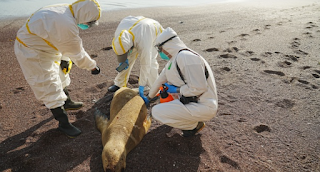
Credit SERNANP
#17,276
Yesterday, in SENASA: Peru Confirms H5N1 In 3 Sea Lions and A Dolphin, we saw the official announcement that 3 dead sea lions, recovered last November, had died from the avian flu virus. What that statement did not tell us, is that hundreds more have died since then, presumably also from H5N1.
Whenever we see a report of a terrestrial or marine mammal that has been infected by (or has died from) HPAI H5N1 in the wild, we must assume there are likely others that were not located, or tested.
The current USDA report (see below) on H5N1 infected mammals (n=110) is almost certainly an undercount, as are reports from other countries.
Yesterday, Peru's custodial agency for protected natural areas - SERNANP - released the following (translated) statement citing nearly 600 sea lion deaths, and the deaths of tens of thousands of birds. Again, this is almost certainly an undercount, as many birds and mammals die unseen in remote or inaccessible areas.
Press release
At least 585 sea lions and about 55,000 birds have died in protected natural areas, victims of Avian Flu.
February 6, 2023 - 4:17 p.m
Given the health alert that our country maintains, due to the confirmation of H5N1 Avian Influenza by the National Agrarian Health Service (Senasa), Sernanp reported that the adoption of new health surveillance and control measures has intensified the presence of its specialist personnel. and park rangers who have registered the death of nearly 55,000 birds in eight protected natural areas of the coast.
The findings of these species have been made in the Lobos de Tierra Islands (Piura and Lambayeque), Lobos de Fuera Islands (Lambayeque), Guañape Islands, Corcovado Islet, Macabí Islands (La Libertad), Santa Island (Ancash), Asia Island, Grupo de Pescadores Islets (Lima), Ballestas Islands, Chinchas Islands, Punta San Juan, Punta Lomitas (Ica), Punta Atico (Arequipa) and Punta Coles (Moquegua) of the Guaneras Islands, Islets and Points System National Reserve.
Likewise, in the Illescas National Reserve (Piura); the Los Pantanos de Villa Wildlife Refuge (Lima); the Ancón Reserved Zone (Lima); the Los Manglares de Tumbes National Sanctuary (Tumbes); the Lagunas de Mejía National Sanctuary (Arequipa); the Paracas National Reserve (Ica) and the San Fernando National Reserve (Ica).
The most affected bird species are mainly boobies, pelicans and guanays, followed by tendrils, Dominican gulls, Peruvian gulls and gray gulls. Also in Franklin's gulls, red-headed vultures, cormorants, Humboldt penguins and others.Sea lionsIn recent weeks, avian influenza in birds has been identified as spreading to populations of sea lions in seven marine-coastal natural protected areas, registering 585 dead sea lions. Faced with this emergency, a first response team made up of experts from Sernanp and WCS have collected samples of the affected fauna, which were analyzed by the veterinary pathology laboratory of the Universidad Nacional Mayor de San Marcos.
The results obtained were positive for Avian Influenza H5N1 for the species of sea lions, Humboldt penguin, booby and oystercatcher. In addition, information has been shared between Minsa, Senasa, Serfor and Sernanp, in order to unify a nationwide database for prevention purposes and adoption of measures for the protection of health against avian influenza.
Anything else:
- The Sernanp, in its role of authority of the Natural Protected Areas, is preparing a diagnosis and monitoring guide for the attention of the sanitary conflict during the emergency caused by said virus.
- If any person observes the presence of animals visibly affected or with signs of disease or dead in one of the PNAs, they should avoid handling them. It is recommended to notify the park rangers.
While none of this guarantees that H5N1 is on a trajectory to becoming a pandemic threat, it's far from being a reassuring sign that it won't.
